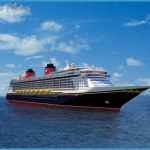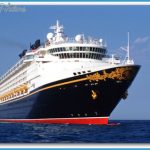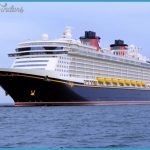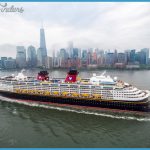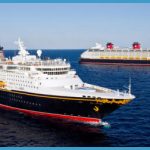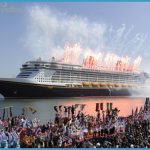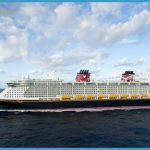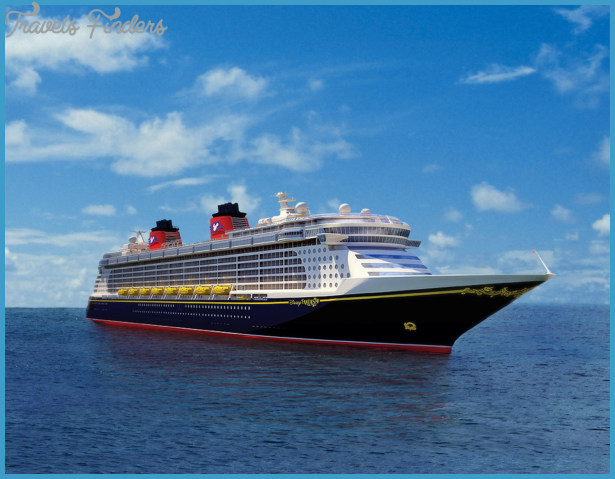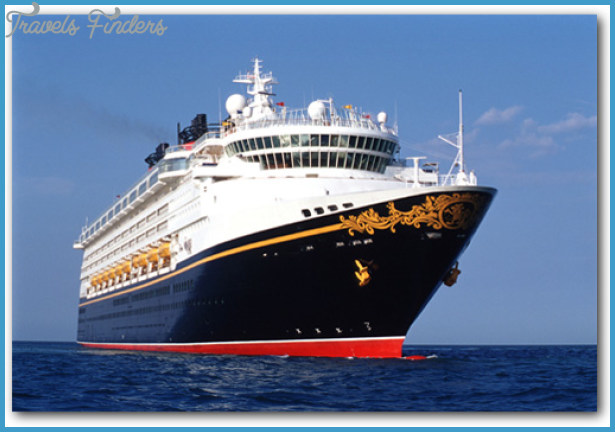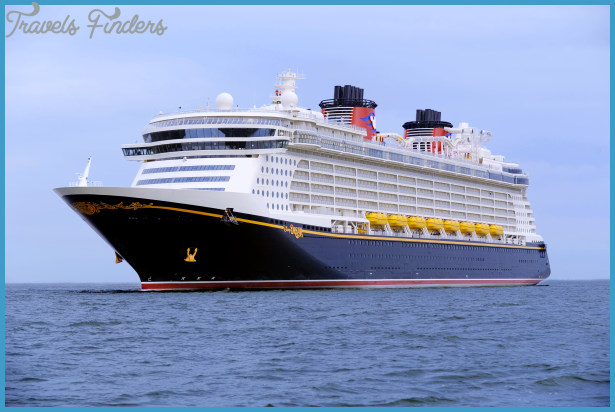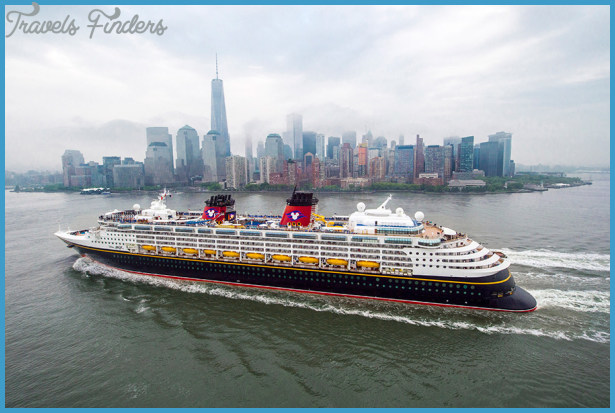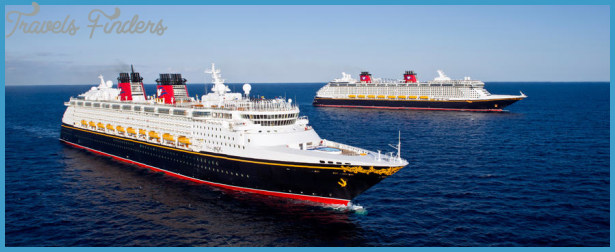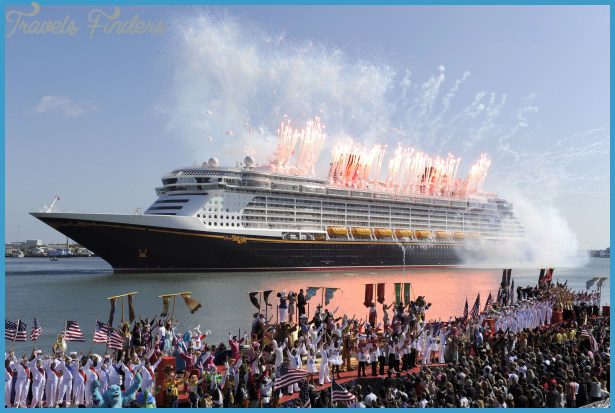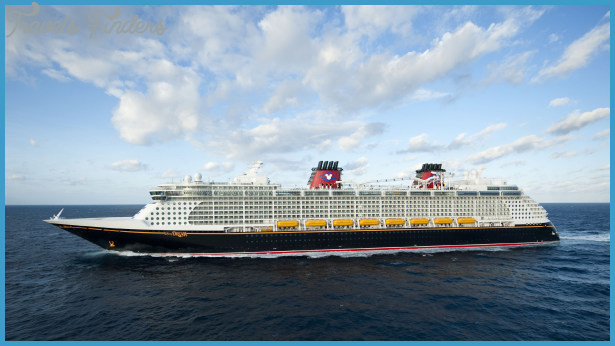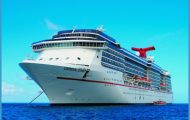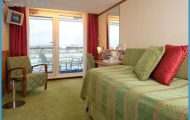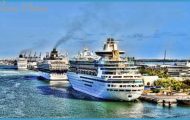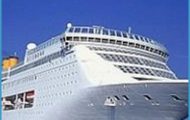Superb Children’s Programs: Would you expect anything less from Disney? In both the size of facilities and the range of activities, it’s impossible to beat this line.
Disney-Quality Entertainment: The line’s family-oriented musicals are some of the best onboard entertainment today.
Family-Style Cabins: It’s rare in the cruise business to find so many large, cabins that can sleep three, four, or even five people, and have split bathrooms with bath tubs so you can get kids ready for bed even faster.
Cons
O Limited Adult Entertainment: Forget about a night out gambling this is one of just a few ships at sea without a casino. There’s an adult-only night entertainment area on board, but it’s often quiet. Packed Pools: Though there are multiple pools on each ship, they’re packed like sardine cans on sunny days, especially the kids’ pools.
Expensive: Compared to other big ship lines such as Carnival and Norwegian, Disney is pricey, running at least a few hundred dollars more.
Overview
Though a number of big lines including Royal Caribbean, Carnival, and Norwegian Cruise Line have long offered entertaining programs for children, it was Disney that first set out expressly to create a family vacation that would be as relaxing for parents as for their offspring. If you love Disney’s resorts on land, you’ll love the company’s ships.
EXPERIENCE
Both classic and ultra-modern, the line’s ships are like no others in the industry, designed to evoke the grand transatlantic liners of old but also boasting truly innovative features, such as extra-large cabins for families and a trio of restaurants through which passengers rotate along with their waiters. Disney is known for entertainment, of course, and its ships don’t disappoint, with inspired stage shows. The vessels also have separate adult pools and lounges and the biggest kids’ facilities at sea. In many ways, the experience is more Disney than it is cruise (for instance, there’s no casino); on the other hand, the ships are surprisingly elegant, but with little Disney touches everywhere, including subliminal mouse ears in many patterns.
ROUTES
Disney Cruise Line does plenty of Caribbean and Bahamas cruises out of Port Canaveral and Miami, some with visits to Castaway Cay, the line’s impressive private island. These ships also sail west, through the Panama Canal, to California, Mexico, Alaska, and Hawaii, and west to Europe.
PASSENGERS
Disney’s ships attract a wide mix of passengers, from honeymooners to seniors, but as one might expect, a big percentage is made up of young American families with children. (This isn’t a big line for foreign passengers, though you’ll see a few.) The bulk of the line’s passengers are first-time cruisers, and because the line attracts so many families (sometimes large ones), many of its bookings are for multiple cabins.
DINING
Disney offers a traditional fixed-seating type plan for dinners, but with a twist. Each of its ships has three main restaurants each with a different theme among which passengers (and, most importantly, their servers) rotate over the course of a cruise. The result: After the first night, servers have drinks waiting on the table when you arrive, including plastic cups with lids and straws and children’s names written on the side. The servers are also able to build a rapport with families over the course of the cruise, and get a sense of which groups need to rush through meals in order to put the kids to bed and which ones want to linger and enjoy their dinner each night.
Rotating through the restaurants keeps things fresh: On one night, passengers dine on dishes such as roasted duck or rack of lamb in a green peppercorn sauce in the nautical-themed Triton’s restaurant. On another night, they enjoy the likes of creole-crusted grouper, braised jerk seasoned pork chop, or mixed grill in the tropical Parrot Cay restaurant. And then it’s on to Animator’s Palate, a bustling eatery with a gimmick: It’s a sort of living animation cell, with walls decorated with black-and-white sketches of Disney characters that over the course of the meal gradually become filled in with color. Video screens add to the illusion, and eventually the characters on screen start to interact with the kids in the audience, wowing the little ones. Even the waiters’ outfits change during the evening. Disney also offers a romantic, adults-only Italian specialty restaurant, Palo, on board its ships that
Comes with an extra charge ($25 per person). Breakfast and lunch are served in several restaurants, both sit-down and buffet. Pluto’s Dog House, on the main pool deck, serves up kid-friendly basics such as chicken fingers, fries, burgers, and nachos; nearby Goofy’s Galley offers wraps, fresh fruit, and other more healthful fare.
One notable feature of Disney ships that sets them apart from other big, mass-market vessels is that soft drinks are included in the fare, and you can find self-serve soda machines around the pool deck and in the buffet area.
ACTIVITIES
Disney offers an array of activities similar to other big-ship lines, with one big exception: There’s no casino. (Disney executives apparently decided a casino just didn’t fit with the line’s family-friendly image.) Besides lounging at the pool or (for kids) heading to the kids’ program, the array of options on board includes basketball, Ping-Pong, and shuffleboard tournaments; sports trivia contests; weight-loss, health, and beauty seminars; bingo, Pictionary, and other games; wine tastings; and singles mixers (though these family-focused cruises aren’t the best choice for singles).
Enrichment activities include galley and backstage theater tours; informal lectures on nautical themes and Disney history; animation and drawing classes; and home entertainment and cooking demonstrations (which highlight local cuisine and ingredients, such as wild salmon on Alaska sailings). All these activities come with no extra charge except for wine tastings ($15/person). There also are dance classes and movies, including first-run films shown in a movie theater that’s probably nicer than the one in your hometown.
The atmosphere onboard is as celebratory here as it is in the Disney parks: All voyages include a captain’s cocktail party with complimentary drinks once per cruise, where the master of the ship and (this being Disney) a gaggle of characters make an appearance and children are given gold streamers to wave in the air as they dance around the pool at sailaway.
CHILDREN’S PROGRAMS
Disney’s kids’ facilities are, famously, the most extensive at sea, spreading across a good part of an entire deck (what the ship lacks in casino space it makes up for with extra kids’ space). The ships carry dozens of children’s counselors who look after groups split into five age groups. The children’s zone generally is open between 9am and midnight. The Oceaneer Club, for ages 3 to 12, is a kiddie-size playroom themed around Captain Hook. Kids can climb and crawl on the bridge, ropes, and rails of a giant pirate ship, as well as on jumbo-size animals, barrels, and a sliding board; play dress-up from trunks full of costumes; dance with Snow White and listen to stories by other Disney characters; or play in the kiddie computer room on PlayStations. The interactive Oceaneer Lab offers kids ages 3 to 10 a chance to work on computers, learn fun science with microscopes, do arts and crafts, hear how animation works, and direct their own TV commercial.
There is also an exclusive hangout for tweens (ages 11-13), and dance parties, karaoke, trivia games, improv comedy lessons, and workshops on photography are offered for teens on every voyage.
One thing Disney doesn’t do is private babysitting. Instead, there’s Flounder’s Reef Nursery for kids ages 3 months to 3 years ($9 per hour for the first child, $8 per each additional child; hours vary depending on the day’s port schedule, and space is limited, so book well in advance). No other lines offer such extensive care for babies; parents are given cell phones so they can check in on their little
Ones from, say, dinner, if they like, and the phones offer a sense of security since parents know they’re reachable should they be needed.
Disney also offers youth activities exclusive to certain regions. In the Caribbean, the line’s private island has a variety of kid-friendly activities, including character meet-and-greets and a splash park for toddlers. On Alaska sailings, while the ship sails through Tracy Arm Fjord, kids can participate in Base Camp on the upper deck. Games, crafts, and activities in Alaska-themed stations entertain children while immersing them in the splendor of the region. During port days, adventure guides specifically for children and teens introduce them to the unique cultural and natural aspects of each Alaskan port.
ENTERTAINMENT
Family-friendly entertainment is one of the highlights of being on a Disney ship, and as one might expect, Disney characters and movies are front and center. Performances by Broadway-caliber entertainers in the nostalgic Walt Disney Theatre include musical medleys of Disney classics and tributes to Disney films through the years combining song, dance, animated films, and special effects. Family game shows (including a trivia contest called Mickey Mania) and karaoke take place in the Studio Sea family nightclub. Adults 18 years and older, meanwhile, have their own play zone, an adults-only entertainment area with three themed nightclubs in the forward part of Deck 3. Another nightspot is the Promenade Lounge, where live music is featured daily. The Buena Vista Theatre shows movies day and evening.
SERVICE
Just as at its parks, Disney’s cruise ships feature staff from around the globe. Service in the dining rooms is efficient and precise, but leans toward friendly rather than formal. The crew keeps the ship exceptionally clean and well maintained. Overall, things run very smoothly.
Services include laundry and dry cleaning. (The ship also has self-service laundry rooms and 1-hr. photo processing.) Tips can be charged to your onboard account, for which most passengers opt, or you can give them out in the traditional method: cash. Disney suggests a gratuity of $28 per person per week for the dining room server, $21 for the assistant server, and $28 for the cabin steward. Disney also recommends tipping the dining room head server $7.
FLEET
The line has four ships, ranging from 2,700 to 4,000 passengers. Everything from cabin layouts to pool deck flow have been well thought out, just like you would find in the parks. And all have those special touches that make it impossible to ever forget you’re on a Disney ship: When the horns blow, you’ll hear the iconic first few bars of classic Disney tunes, such as When You Wish Upon a Star. You’ll also find subliminal mouse heads known as Hidden Mickey’s hidden all over the ship.
THE SHIPS IN GENERAL
Built in 1998 and 1999, these majestic ships carry 1,754 passengers at the rate of two per cabin, but because Disney is a family company and its ships were built expressly to carry three, four, and five people in virtually every cabin, the ship could theoretically carry a whopping 3,325 passengers with all berths full though that only tends to happen during peak travel times. These high numbers mean certain areas of the ship will feel crowded at times, namely the kids’ pool area, the buffet restaurants, and the photo gallery and shops after dinner. Overall, though, the ships are well laid out and have aged gracefully, with frequent updates, refurbishments and new amenities added all the time.
Cabins The Disney ships have the most family-friendly cabins at sea, with standard accommodations equivalent to the suites or demisuites on most ships they’re about 25% larger than the industry standard and all have at least a sitting area with a sofa bed to sleep families of three (or four if you put two small children on the sofa bed). Some cabins also have one or two pull-down bunks. Nearly half have private verandas. One-bedroom suites have private verandas and sleep four or five comfortably; two-bedroom suites sleep seven. Note: Due to the beds being lower to the ground than on most other ships, you may not be able to stow your suitcases underneath and will have to resort to taking up precious closet space with luggage.
The decor is virtually identical from cabin to cabin, with nostalgic ocean-liner elements such as a steamer-trunk armoire, globe- and telescope-shaped lamps, map designs on the bedspreads, and a framed black-and-white 1930s shot of Mr. and Mrs. Walt Disney aboard the fabled ocean liner Rex. Warm wood tones predominate, with Art Deco touches in the metal and glass fittings and light fixtures. The majority of cabins have two bathrooms a sink and toilet in one and a shower/tub combo and a sink in the other. This is something you won’t find in any other standard cabin industrywide, and it’s a great boon for families.
Sixteen cabins are fitted for wheelchair users.
Public areas & activities Both ships have several theaters and lounges, including an adults-only area with three separate venues: a piano/jazz lounge, disco, and sports-pub-cum-karaoke bar. There’s also a family-oriented entertainment lounge called Studio Sea for game shows, karaoke, and dancing; and a 24-hour Internet cafe. A 270-seat cinema shows mostly recent-release Disney movies along with a screen attached to the forward funnel, which shows classic Disney animated films. The children’s facilities are the largest of any ship at sea (see Children’s Program, above, for details).
Throughout, both ships have some of the best artwork at sea, owing to Disney’s vast archive of animation cels, production sketches, costume studies, and inspirational artwork. Canned music pumped into the public areas and corridors tends toward big-band music and crooner tunes or surf-type pop.
The Pool Deck of each ship has three pools: Mickey’s Kids’ Pool, shaped like the mouse’s big-
Eared head, with a great big, white-gloved Mickey hand holding up a snaking yellow slide (this pool can get cr-o-o-o-w-ded!); Goofy’s Family Pool, where adults and children can mingle; and the Quiet Cove Adult Pool. A consolation prize for families with young children is a splash pool with circulating water for diaper-wearing babies and toddlers. It’s the only one at sea, as usually diaper-wearing children (and that includes pull-ups and swim diapers) are not allowed in any pool, for hygiene reasons. On both ships, there is now a new larger toddler pool with interactive fountains and splash zones. Disney Magic also has the AquaDunk, a three-story waterslide with a transparent section of tube that cantilevers out over the side of the ship.
Just beyond the adult pool area is an impressive spa and gym Among the many treatments is a selection geared to teens. Both ships’ spas have been remodeled and three spa villas were added. Each one is an indoor (and quite pricey) treatment suite that’s connected to a private outdoor veranda with a personal hot tub, an open-air shower, and a chaise longue.
Both ships have an outdoor Sports Deck with basketball and paddle tennis. There is also shuffleboard and Ping-Pong.
Dining Disney’s unique rotation dining setup has guests sampling three different restaurants at dinner over the course of their cruise, with an adults-only specialty restaurant also available, by reservation only (see Dining, earlier in this section). At breakfast and lunch, most go for the buffet-style spread in Magic ‘s Topsider and Wonder ‘s Beach Blanket restaurants. Though the culinary offerings are fine, the layout and tiny size of these restos are not. Be prepared to head to other options like the poolside Pinocchio’s Pizzeria; Pluto’s Dog House for hot dogs, hamburgers, chicken tenders, fries, and more; and Goofy’s Galley for wraps, fruit, and ice cream There’s also 24-hour room service from a limited menu.
The 4,000-guest Disney Dream debuted in 2011, and her sister Disney Fantasy followed in 2012. At 1,115 feet in length, they’re the largest ships that Disney has ever built, and the first since the launch of Disney Wonder back in 1999. Like their siblings, they play up the grand transatlantic ocean liner lookto the hilt and add new and innovative features.
In addition to expanding upon the stellar kids’ programs Disney is known for, these two ships have
Some decidedly cool toys, like the AquaDuck, a 765-foot long water coaster that takes guests on a journey through four decks of translucent tubing that cantilevers out over the side of the ship. They also introduced virtual portholes in Inside Staterooms: sophisticated LED screens designed to mimic a real window that are linked to position-relative cameras mounted to the outside of the ship. Of course, in true Disney fashion, famous cartoon characters appear in on these windows periodically.
Another neat Disney innovation is the addition of a set of rechargeable Wave Phones that can be used to keep tabs on family members around the ship. They’re loaned to all guests, regardless of cabin category.
Both ships currently sail the Caribbean, with Disney Fantasy offering weeklong departures and Disney Dream operating shorter three, four and five-night sailings to the Bahamas from Port Canaveral.
Cabins Both ships have 1,250 staterooms and suites onboard, and all of them are among the largest at sea. All feature heavy curtain dividers to section off the bed and pull-out couch sleeping areas, as well as sectional bathrooms with a shower/tub and sink in one room, and a toilet and sink in the other.
The ship’s 150 Inside Staterooms are designed to sleep three to four guests, and include Disney’s Magic Porthole window (see above). Although they’re not overly huge, these are some of the most handsome inside staterooms we’ve seen, with real teak accents and plenty of Art Deco touches. Deluxe Oceanview Staterooms are the same size, but have a real (and large) porthole though be warned: Categories 9C and 9D have porthole windows with obstructed views. Deluxe Family Oceanview Staterooms are larger, can sleep up to five, and feature one or two large porthole windows.
Deluxe Oceanview Stateroom with Verandah categories include a private balcony with a plexiglass railing (an important feature, as kids aren’t tempted to climb it), and can sleep up to five.
If you’ve got cash to burn (we mean it these rooms are ex-pen-sive ), you can indulge in one of the top-of-the-line Concierge Suites which have upgraded amenities like a pillow menu and access to a Media Library where guests can rent CD’s, DVD’s, video games and board games to enjoy in the comfort of their suite. The top of the line: the Royal Suites, which are as big as a small house and feature a gigantic balcony that has its own dining table and padded lounges, plus two bathrooms, separated living and sleeping areas, a pantry with wet bar, and an open dining salon.
Public rooms & activities Disney does a superb job at keeping kids and adults separate. To that end, nearly all the dedicated kids’ facilities, from the onboard nursery to the Oceaneer Club and Oceaneer Lab, take up the better part of Deck 5. One deck lower, Deck 4 is dedicated to adult pursuits, with a collection of pubs and handsome lounges. Our favorite: the Skyline Lounge, which features rotating vistas of famous locales around the world as wall decoration. It sounds chintzy, but it’s not: Much like the company’s theme parks, it doesn’t take long for adults to fall under the Disney spell.
Production shows held in the two-story Disney Theatre and are topnotch; first-run Disney movies are shown in the two-story cinema. As we said earlier, there’s no casino onboard (a rarity on mainstream cruise lines).
In addition to the AquaDuck (see above), each ship has a variety of pools and hot tubs designed for kids and adults alike. Adults can get away from the little ones at the Quiet Cove Adult Pool (with its
Adjacent bar), while kids can enjoy the shallow Mickey’s Pool and adjacent kid-friendly yellow Mickey’s Slide waterslide; and the deeper Donald’s Family Pool. The latter also happens to be located in the shadow of the 24-foot tall LED screen affixed to the funnel. Like Disney’s other ships, things can get very crowded here on sea days.
Up on Deck 11, the Senses Spa is absolutely superb, with an indulgent Thermal Suite, featuring rainforest-themed aromatherapy steam rooms, a dry sauna fashioned after a Roman bath, and private luxury spa villas that can be booked as an individual, couples, or as the whole family (for a hefty fee). Disney even offers a special Chill Spa for teenagers aged 13 to 17, with customized treatments designed just for them
Both ships have decently sized Fitness Centers adjacent to the spa. Goofy’s Sports Deck includes a mini-golf course, a basketball court, Ping-Pong and foosball tables, shuffleboard, a running track, and virtual sports simulators.
Dining Rotation dining returns to Disney Dream and Disney Fantasy, with guests moving through the Animator’s Palette, Enchanted Garden, and the more formal Royal Palace along with their tablemates and wait staff. While the change in scenery is a swell touch, it’s the waiters that really rise to the occasion, making kids big and small feel welcomed. Guests can choose to dine at either 5:45 p.m or 8:15 p.m Food is better-than-average.
Among the many casual dining options aboard are the buffet Cabanas; Flo’s Cafe for the usual burgers, pizza by the slice, hot dogs, salads and sandwiches).
The real venues to write home about are reserved for adults. Paolo ($30 extra) returns to both ships, with Italian-inspired menus for dinner and a sea day Champagne Bruch that always sells out. The dining venue that will have you exclaiming, however, is Remy (ouch: $85 extra). Don’t let the fact that it’s named for the animated star of the movie Ratatouille put you off; this is one of the most elegant specialty restaurants at sea, a cross between a French bistro and a wood-paneled Pullman car on the Orient Express. The food is spectacular, crafted by Chef Arnaud Lallement of l’Assiette Champenoise, a Michelin 3-star restaurant located near Reims, France; and Chef Scott Hunnel from award-winning Victoria & Albert’s at Walt Disney World Resort.

